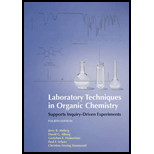
Interpretation:
The reason for the broader melting point range observed for second sample should be determined.
Concept introduction:
For a crystalline substance, the temperature at which the substance changes from solid phase to liquid phase is referred to as melting point. Melting point is directly associated with the presence of intermolecular forces like hydrogen bonding, dipole-dipole interactions. High molecular symmetry, large surface area, polarity is related to high melting temperature.
A pure compound melt at a narrow range and compounds with impurities have broad melting temperature. Melting points are obtained by filling the organic compound into the capillary tube with one end sealed.
Explanation of Solution
To determine the melting point of a sample the capillary tube is filled with a sample with one end sealed. After that, the sample is heated to a temperature where the solid sample begins to convert into a liquid phase which signifies its melting point.
If too much sample is added to the capillary, the range of melting point becomes broad as more time it takes to melt the whole sample while the temperature of the sample increases with time.
Therefore the sample height of
Want to see more full solutions like this?
Chapter 14 Solutions
Laboratory Techniques in Organic Chemistry
- What is the final product when hexanedioic acid reacts with 1º PCl5 and 2º NH3.arrow_forwardWhat is the final product when D-galactose reacts with hydroxylamine?arrow_forwardIndicate the formula of the product obtained by reacting methyl 5-chloro-5-oxopentanoate with 1 mole of 4-penten-1-ylmagnesium bromide.arrow_forward
- The temperature on a sample of pure X held at 1.25 atm and -54. °C is increased until the sample boils. The temperature is then held constant and the pressure is decreased by 0.42 atm. On the phase diagram below draw a path that shows this set of changes. pressure (atm) 2 0 0 200 400 temperature (K) Xarrow_forwardQUESTION: Answer Question 5: 'Calculating standard error of regression' STEP 1 by filling in all the empty green boxes *The values are all provided in the photo attached*arrow_forwardpressure (atm) 3 The pressure on a sample of pure X held at 47. °C and 0.88 atm is increased until the sample condenses. The pressure is then held constant and the temperature is decreased by 82. °C. On the phase diagram below draw a path that shows this set of changes. 0 0 200 temperature (K) 400 аarrow_forward
 Chemistry: The Molecular ScienceChemistryISBN:9781285199047Author:John W. Moore, Conrad L. StanitskiPublisher:Cengage Learning
Chemistry: The Molecular ScienceChemistryISBN:9781285199047Author:John W. Moore, Conrad L. StanitskiPublisher:Cengage Learning EBK A SMALL SCALE APPROACH TO ORGANIC LChemistryISBN:9781305446021Author:LampmanPublisher:CENGAGE LEARNING - CONSIGNMENT
EBK A SMALL SCALE APPROACH TO ORGANIC LChemistryISBN:9781305446021Author:LampmanPublisher:CENGAGE LEARNING - CONSIGNMENT Macroscale and Microscale Organic ExperimentsChemistryISBN:9781305577190Author:Kenneth L. Williamson, Katherine M. MastersPublisher:Brooks Cole
Macroscale and Microscale Organic ExperimentsChemistryISBN:9781305577190Author:Kenneth L. Williamson, Katherine M. MastersPublisher:Brooks Cole


